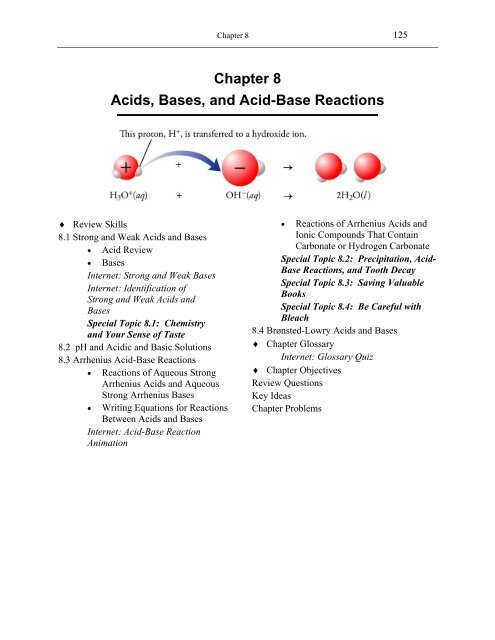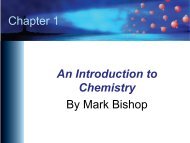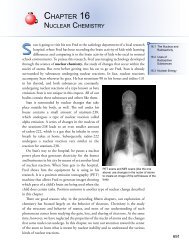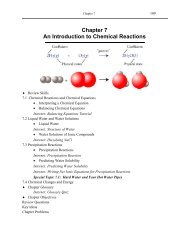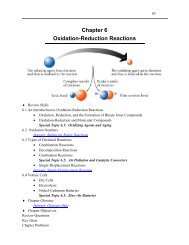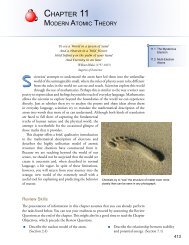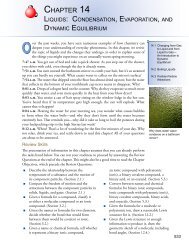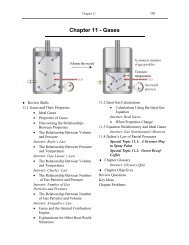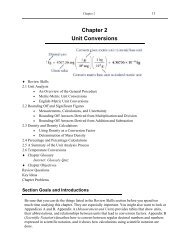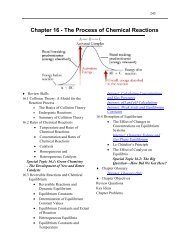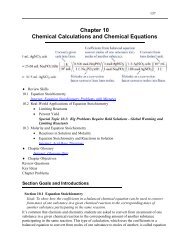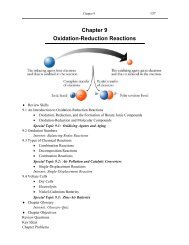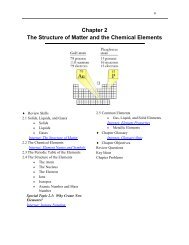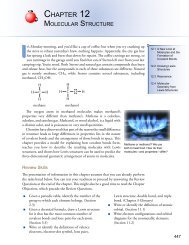Chapter 8 Acids, Bases, and Acid-Base Reactions - An Introduction ...
Chapter 8 Acids, Bases, and Acid-Base Reactions - An Introduction ...
Chapter 8 Acids, Bases, and Acid-Base Reactions - An Introduction ...
Create successful ePaper yourself
Turn your PDF publications into a flip-book with our unique Google optimized e-Paper software.
<strong>Chapter</strong> 8 125<br />
<strong>Chapter</strong> 8<br />
<strong><strong>Acid</strong>s</strong>, <strong><strong>Base</strong>s</strong>, <strong>and</strong> <strong>Acid</strong>-<strong>Base</strong> <strong>Reactions</strong><br />
Review Skills<br />
8.1 Strong <strong>and</strong> Weak <strong><strong>Acid</strong>s</strong> <strong>and</strong> <strong><strong>Base</strong>s</strong><br />
<strong>Acid</strong> Review<br />
<strong><strong>Base</strong>s</strong><br />
Internet: Strong <strong>and</strong> Weak <strong><strong>Base</strong>s</strong><br />
Internet: Identification of<br />
Strong <strong>and</strong> Weak <strong><strong>Acid</strong>s</strong> <strong>and</strong><br />
<strong><strong>Base</strong>s</strong><br />
Special Topic 8.1: Chemistry<br />
<strong>and</strong> Your Sense of Taste<br />
8.2 pH <strong>and</strong> <strong>Acid</strong>ic <strong>and</strong> Basic Solutions<br />
8.3 Arrhenius <strong>Acid</strong>-<strong>Base</strong> <strong>Reactions</strong><br />
<strong>Reactions</strong> of Aqueous Strong<br />
Arrhenius <strong><strong>Acid</strong>s</strong> <strong>and</strong> Aqueous<br />
Strong Arrhenius <strong><strong>Base</strong>s</strong><br />
Writing Equations for <strong>Reactions</strong><br />
Between <strong><strong>Acid</strong>s</strong> <strong>and</strong> <strong><strong>Base</strong>s</strong><br />
Internet: <strong>Acid</strong>-<strong>Base</strong> Reaction<br />
<strong>An</strong>imation<br />
<strong>Reactions</strong> of Arrhenius <strong><strong>Acid</strong>s</strong> <strong>and</strong><br />
Ionic Compounds That Contain<br />
Carbonate or Hydrogen Carbonate<br />
Special Topic 8.2: Precipitation, <strong>Acid</strong>-<br />
<strong>Base</strong> <strong>Reactions</strong>, <strong>and</strong> Tooth Decay<br />
Special Topic 8.3: Saving Valuable<br />
Books<br />
Special Topic 8.4: Be Careful with<br />
Bleach<br />
8.4 Brønsted-Lowry <strong><strong>Acid</strong>s</strong> <strong>and</strong> <strong><strong>Base</strong>s</strong><br />
<strong>Chapter</strong> Glossary<br />
Internet: Glossary Quiz<br />
<strong>Chapter</strong> Objectives<br />
Review Questions<br />
Key Ideas<br />
<strong>Chapter</strong> Problems
126 Study Guide for <strong>An</strong> <strong>Introduction</strong> to Chemistry<br />
Section Goals <strong>and</strong> <strong>Introduction</strong>s<br />
Section 8.1 Strong <strong>and</strong> Weak <strong><strong>Acid</strong>s</strong> <strong>and</strong> <strong><strong>Base</strong>s</strong><br />
Goals<br />
To review some of the information about acids described in Section 6.3.<br />
To describe bases <strong>and</strong> to make the distinction between strong <strong>and</strong> weak bases.<br />
To show how you can recognize strong <strong>and</strong> weak bases.<br />
To show the changes that take place on the particle level when bases dissolve in water.<br />
This section begins with a review of acids, followed by the following for bases: (1) it states<br />
the Arrhenius definition of base, (2) it provides you with the information necessary to identify<br />
strong <strong>and</strong> weak bases, <strong>and</strong> (3) it describes the changes that take place when one weak base<br />
(ammonia) dissolves in water (Figure 8.2). Sample Study Sheet 8.1 summarizes the steps for<br />
identification of strong <strong>and</strong> weak acids <strong>and</strong> bases. Visit our Web site for more information<br />
about strong <strong>and</strong> weak bases <strong>and</strong> the identification of strong <strong>and</strong> weak acids <strong>and</strong> bases.<br />
Internet: Strong <strong>and</strong> Weak <strong><strong>Base</strong>s</strong><br />
Internet: Identification of Strong <strong>and</strong> Weak <strong><strong>Acid</strong>s</strong> <strong>and</strong> <strong><strong>Base</strong>s</strong><br />
Section 8.2 pH <strong>and</strong> <strong>Acid</strong>ic <strong>and</strong> Basic Solutions<br />
Goal: To explain the pH scale used to describe acidic <strong>and</strong> basic solutions.<br />
This section provides an introduction to the pH scale used to describe acidic <strong>and</strong> basic<br />
solutions. Figure 8.4 contains the most important information.<br />
Section 8.3 Arrhenius <strong>Acid</strong>-<strong>Base</strong> <strong>Reactions</strong><br />
Goals<br />
To describe acid-base reactions, with an emphasis on developing the ability to visualize<br />
the changes that take place on the particle level.<br />
To show how you can predict whether two reactants will react in an acid-base reaction.<br />
To show how to write equations for acid-base reactions.<br />
This section does for acid-base reactions what Section 7.3 does for precipitation reactions. It<br />
might help to consider the similarities <strong>and</strong> differences between these two types of chemical<br />
changes. Be sure that you can visualize the changes that take place at the particle level for<br />
both types of chemical reactions. Pay special attention to Figures 8.5, 8.6, <strong>and</strong> 8.8. Visit our<br />
Web site to see an animation showing an acid-base reaction.<br />
Internet: <strong>Acid</strong>-<strong>Base</strong> Reaction <strong>An</strong>imation<br />
Section 8.4 Brønsted-Lowry <strong><strong>Acid</strong>s</strong> <strong>and</strong> <strong><strong>Base</strong>s</strong><br />
Goal: To describe a second set of definitions for acid, base, <strong>and</strong> acid-base reactions, called<br />
the Brønsted-Lowry definitions.<br />
Although the Arrhenius definitions of acid, base, <strong>and</strong> acid-base reactions provided in Sections<br />
8.1 <strong>and</strong> 8.3 are very important, especially to the beginning chemistry student, chemists have<br />
found it useful to extend these definitions to include new substances as acids <strong>and</strong> bases that<br />
would not be classified as such according to the Arrhenius definitions. The new definitions,<br />
called the Brønsted-Lowry definitions, are described in this section.
<strong>Chapter</strong> 8 127<br />
<strong>Chapter</strong> 8 Map<br />
<strong>Chapter</strong> Checklist<br />
Read the Review Skills section. If there is any skill mentioned that you have not yet<br />
mastered, review the material on that topic before reading this chapter.<br />
Read the chapter quickly before the lecture that describes it.<br />
Attend class meetings, take notes, <strong>and</strong> participate in class discussions.<br />
Work the <strong>Chapter</strong> Exercises, perhaps using the <strong>Chapter</strong> Examples as guides.<br />
Study the <strong>Chapter</strong> Glossary <strong>and</strong> test yourself on our Web site:<br />
Internet: Glossary Quiz<br />
Study all of the <strong>Chapter</strong> Objectives. You might want to write a description of how you<br />
will meet each objective. (Although it is best to master all of the objectives, the following
128 Study Guide for <strong>An</strong> <strong>Introduction</strong> to Chemistry<br />
objectives are especially important because they pertain to skills that you will need while<br />
studying other chapters of this text: 5, 6, 7, 8, 11, <strong>and</strong> 18.)<br />
Reread Sample Study Sheet 8.1: Identification of Strong <strong>and</strong> Weak <strong><strong>Acid</strong>s</strong> <strong>and</strong> <strong><strong>Base</strong>s</strong> <strong>and</strong><br />
decide whether you will use it or some variation on it to complete the task it describes.<br />
Memorize the following. Be sure to check with your instructor to determine how much<br />
you are expected to know of the following.<br />
The significance of the numbers in the pH scale<br />
To get a review of the most important topics in the chapter, fill in the blanks in the Key<br />
Ideas section.<br />
Work all of the selected problems at the end of the chapter, <strong>and</strong> check your answers with<br />
the solutions provided in this chapter of the study guide.<br />
Ask for help if you need it.<br />
Web Resources<br />
Internet: Strong <strong>and</strong> Weak <strong><strong>Base</strong>s</strong><br />
Internet: Identification of<br />
Internet: Strong <strong>and</strong> Weak <strong><strong>Acid</strong>s</strong> <strong>and</strong> <strong><strong>Base</strong>s</strong><br />
Internet: <strong>Acid</strong>-<strong>Base</strong> Reaction <strong>An</strong>imation<br />
Internet: Glossary Quiz<br />
Exercises Key<br />
Exercise 8.1 - Identification of <strong><strong>Acid</strong>s</strong> <strong>and</strong> <strong><strong>Base</strong>s</strong>: Identify each of the following as an<br />
Arrhenius strong acid, an Arrhenius weak acid, an Arrhenius strong base, or an Arrhenius weak<br />
base. (Obj 5)<br />
a. HNO 3 strong acid<br />
b. lithium hydroxide strong base<br />
c. K 2 CO 3 weak base<br />
d. hydrofluoric acid weak acid
<strong>Chapter</strong> 8 129<br />
Exercise 8.2 - Neutralization <strong>Reactions</strong>: Write the complete equation for the<br />
neutralization reactions that take place when the following water solutions are mixed. (If an acid<br />
has more than one acidic hydrogen, assume that there is enough base to remove all of them.<br />
Assume that there is enough acid to neutralize all of the basic hydroxide ions.) (Obj 11)<br />
a. HCl(aq) NaOH(aq) H 2 O(l) NaCl(aq)<br />
b. HF(aq) LiOH(aq) H 2 O(l) LiF(aq)<br />
c. H 3 PO 4 (aq) 3LiOH(aq) 3H 2 O(l) Li 3 PO 4 (aq)<br />
d. Fe(OH) 3 (s) 3HNO 3 (aq) Fe(NO 3 ) 3 (aq) 3H 2 O(l)<br />
Exercise 8.3 - Neutralization <strong>Reactions</strong> with Compounds Containing Carbonate:<br />
Write the complete equation for the neutralization reaction that takes place when water solutions<br />
of sodium carbonate, Na 2 CO 3 , <strong>and</strong> hydrobromic acid, HBr, are mixed. (Obj 11)<br />
Na 2 CO 3 (aq) 2HBr(aq) 2NaBr(aq) H 2 O(l) CO 2 (g)<br />
Exercise 8.4 - Conjugate <strong><strong>Acid</strong>s</strong>: Write the formula for the conjugate acid of (a) NO – 2 , (b)<br />
HCO – 3 , (c) H 2 O, <strong>and</strong> (d) PO 3– 4 . (Obj 14)<br />
a. HNO 2 b. H 2 CO 3 c. H 3 O 2–<br />
d. HPO 4<br />
Exercise 8.5 - Conjugate <strong><strong>Base</strong>s</strong>: Write the formula for the conjugate base of (a) H 2 C 2 O 4 ,<br />
(b) HBrO 4 , (c) NH 3 , <strong>and</strong> (d) H 2 PO – 4 . (Obj 15)<br />
–<br />
–<br />
–<br />
2–<br />
a. HC 2 O 4 b. BrO 4 c. NH 2 d. HPO 4<br />
Exercise 8.6 - Brønsted-Lowry <strong><strong>Acid</strong>s</strong> <strong>and</strong> <strong><strong>Base</strong>s</strong>: Identify the Brønsted-Lowry acid <strong>and</strong><br />
base in each of the following equations. (Obj 18)<br />
a. HNO 2 (aq) NaBrO(aq) HBrO(aq) NaNO 2 (aq)<br />
B/L acid B/L base<br />
b. H 2 AsO – 4 (aq) HNO 2 (aq) H 3 AsO 4 (aq) NO – 2 (aq)<br />
B/L base B/L acid<br />
c. H 2 AsO – 4 (aq) 2OH – (aq) AsO 3– 4 (aq) 2H 2 O(l)<br />
B/L acid B/L base<br />
Review Questions Key<br />
1. Define the following terms.<br />
a. aqueous<br />
Water solutions are called aqueous solutions.<br />
b. spectator ion<br />
Ions that are important for delivering other ions into solution to react, but do not<br />
actively participate in the reaction themselves are called spectator ions.<br />
c. double-displacement reaction<br />
A chemical reaction that has the following form is called a double-displacement<br />
reaction.<br />
AB + CD AD + CB
130 Study Guide for <strong>An</strong> <strong>Introduction</strong> to Chemistry<br />
d. net ionic equation<br />
A net ionic equation is a chemical equation for which the spectator ions have<br />
been eliminated, leaving only the substances actively involved in the reaction.<br />
2. Write the name of the polyatomic ions represented by the formulas CO 2– 3 <strong>and</strong> HCO – 3 .<br />
2–<br />
a. CO 3 carbonate b. HCO – 3 hydrogen carbonate<br />
3. Write the formulas for the polyatomic ions dihydrogen phosphate ion <strong>and</strong> acetate ion.<br />
–<br />
–<br />
a. dihydrogen phosphate ion H 2 PO 4 b. acetate ion C 2 H 3 O 2<br />
4. Which of the following formulas represent an ionic compound?<br />
a. MgCl 2 ionic<br />
b. PCl 3 not ionic<br />
c. KHSO 4 ionic<br />
d. Na 2 SO 4 ionic<br />
e. H 2 SO 3 not ionic<br />
5. Write the names that correspond to the formulas KBr, Cu(NO 3 ) 2 , <strong>and</strong> (NH 4 ) 2 HPO 4 .<br />
f. KBr potassium bromide h. (NH 4 ) 2 HPO 4 ammonium hydrogen<br />
g. Cu(NO 3 ) 2 copper(II) nitrate<br />
phosphate<br />
6. Write the formulas that correspond to the names nickel(II) hydroxide, ammonium chloride,<br />
<strong>and</strong> calcium hydrogen carbonate.<br />
a. nickel(II) hydroxide Ni(OH) 2 c. calcium hydrogen carbonate<br />
b. ammonium chloride NH 4 Cl<br />
Ca(HCO 3 ) 2<br />
7. Predict whether each of the following is soluble or insoluble in water.<br />
a. iron(III) hydroxide insoluble c. aluminum nitrate soluble<br />
b. barium sulfate insoluble d. copper(II) chloride soluble<br />
8. Describe how the strong monoprotic acid hydrochloric acid, HCl acts when it is added to<br />
water, including a description of the nature of the particles in solution before <strong>and</strong> after the<br />
reaction with water. If there is a reversible reaction with water, describe the forward <strong>and</strong> the<br />
reverse reactions.<br />
When HCl molecules dissolve in water, each HCl molecule donates a proton, H + , to<br />
water forming a hydronium ion, H 3 O + , <strong>and</strong> a chloride ion, Cl . This reaction goes to<br />
completion, <strong>and</strong> the solution of the HCl contains essentially no uncharged acid<br />
molecules. Once the chloride ion <strong>and</strong> the hydronium ion are formed, the negatively<br />
charged oxygen atoms of the water molecules surround the hydronium ion <strong>and</strong> the<br />
positively charged hydrogen atoms of the water molecules surround the chloride ion.<br />
Figure 6.2 shows you how you can picture this solution.<br />
9. Describe how the weak monoprotic acid acetic acid, HC 2 H 3 O 2 , acts when it is added to<br />
water, including a description of the nature of the particles in solution before <strong>and</strong> after the<br />
reaction with water. If there is a reversible reaction with water, describe the forward <strong>and</strong> the<br />
reverse reactions.<br />
When an acetic acid molecule, HC 2 H 3 O 2 , collides with an H 2 O molecule, an H + can be<br />
transferred to the water to form a hydronium ion, H 3 O + , <strong>and</strong> an acetate ion, C 2 H 3 O 2 .<br />
The C 2 H 3 O 2 ions formed in solution reverse the change by reacting with the hydronium<br />
ions <strong>and</strong> pulling H + ions back to reform HC 2 H 3 O 2 <strong>and</strong> H 2 O. The forward <strong>and</strong> reverse<br />
reactions take place constantly, <strong>and</strong> soon after the addition of HC 2 H 3 O 2 to water, they<br />
proceed at an equal rate. There is no net change in the amounts of the HC 2 H 3 O 2 , H 2 O,<br />
C 2 H 3 O 2 , or H 3 O + in the solution. See Figure 6.6.
<strong>Chapter</strong> 8 131<br />
10. Describe the process by which the ionic compound sodium hydroxide dissolves in water.<br />
When solid sodium hydroxide, NaOH, is added to water, all of the sodium ions, Na + , <strong>and</strong><br />
hydroxide ions, OH – , at the surface of the solid can be viewed as shifting back <strong>and</strong> forth<br />
between moving out into the water <strong>and</strong> returning to the solid surface. Sometimes when an<br />
ion moves out into the water, a water molecule collides with it, helping to break the ionic<br />
bond, <strong>and</strong> pushing it out into the solution. Water molecules move into the gap between<br />
the ion in solution <strong>and</strong> the solid <strong>and</strong> shield the ion from the attraction to the solid.<br />
The ions are kept stable <strong>and</strong> held in solution by attractions between them <strong>and</strong> the polar<br />
water molecules. The negatively charged oxygen ends of water molecules surround the<br />
sodium ions, <strong>and</strong> the positively charged hydrogen ends of water molecules surround the<br />
hydroxide ions. (See Figures 7.7 <strong>and</strong> 7.8 with OH – in the place of Cl – .)<br />
11. Write the complete equation for the precipitation reaction that takes place when water<br />
solutions of zinc chloride <strong>and</strong> sodium phosphate are mixed.<br />
3ZnCl 2 (aq) 2Na 3 PO 4 (aq) Zn 3 (PO 4 ) 2 (s) 6NaCl(aq)<br />
Key Ideas <strong>An</strong>swers<br />
12. According to the modern version of the Arrhenius theory of acids <strong>and</strong> bases, a base is a<br />
substance that produces hydroxide ions, OH – , when it is added to water.<br />
14. Compounds that contain hydroxide ions are often called hydroxides.<br />
16. A weak base is a base that produces fewer hydroxide ions in water solution than there are<br />
particles of base dissolved.<br />
18. Basic solutions have pH values greater than 7, <strong>and</strong> the more basic the solution is, the higher<br />
its pH.<br />
20. When an Arrhenius acid is combined with an Arrhenius base, we say that they neutralize<br />
each other.<br />
22. Most Arrhenius neutralization reactions, such as the reaction between nitric acid <strong>and</strong> sodium<br />
hydroxide, are double-displacement reactions.<br />
24. A Brønsted-Lowry acid is a proton (H ) donor, a Brønsted-Lowry base is a proton acceptor,<br />
<strong>and</strong> a Brønsted-Lowry acid-base reaction is a proton transfer.<br />
26. The conjugate base of a molecule or ion is the molecule or ion that forms when one H ion is<br />
removed.<br />
28. The Brønsted-Lowry system is often used to describe specific acid-base reactions, but the<br />
Arrhenius system is used to describe whether isolated substances are acids, bases, or neither.<br />
Problems Key<br />
Section 8.1 Strong <strong>and</strong> Weak Arrhenius <strong><strong>Base</strong>s</strong><br />
30. Classify each of the following substances as a weak acid, strong acid, weak base, or strong<br />
base in the Arrhenius acid-base sense. (Obj 5)<br />
a. H 2 CO 3 weak acid<br />
b. cesium hydroxide strong base<br />
c. HF(aq) weak acid<br />
d. sodium carbonate weak base<br />
e. NH 3 weak base<br />
f. chlorous acid weak acid<br />
g. HCl(aq) strong acid<br />
h. benzoic acid weak acid
132 Study Guide for <strong>An</strong> <strong>Introduction</strong> to Chemistry<br />
Section 8.2 pH <strong>and</strong> <strong>Acid</strong>ic <strong>and</strong> Basic Solutions<br />
32. Classify each of the following solutions as acidic, basic, or neutral. (Obj 6)<br />
a. tomato juice with a pH of 4.53 pH < 7, so acidic<br />
b. milk of magnesia with a pH of 10.4 pH > 7, so basic<br />
c. urine with a pH of 6.8 pH about 7, so essentially neutral (or more<br />
specifically, very slightly acidic)<br />
34. Which is more acidic, carbonated water with a pH of 3.95 or milk with a pH of 6.3?<br />
(Obj 7)<br />
The lower the pH is, the more acidic the solution. Carbonated water is more acidic than<br />
milk.<br />
36. Identify each of the following characteristics as associated with acids or bases.<br />
a. tastes sour acid<br />
b. turns litmus red acid<br />
c. reacts with HNO 3 base<br />
Section 8.3 Arrhenius <strong>Acid</strong>-<strong>Base</strong> <strong>Reactions</strong><br />
38. Describe the process that takes place between the participants in each of the following<br />
neutralization reactions, mentioning the nature of the particles in the solution before <strong>and</strong> after<br />
the reaction. The strong acid hydrochloric acid, HCl(aq), <strong>and</strong> the strong base sodium<br />
hydroxide, NaOH(aq), form water <strong>and</strong> sodium chloride, NaCl(aq). (Obj 10A)<br />
Because hydrochloric acid, HCl(aq), is an acid, it reacts with water to form hydronium<br />
ions, H 3 O + , <strong>and</strong> chloride ions, Cl – . Because it is a strong acid, the reaction is a<br />
completion reaction, leaving only H 3 O + <strong>and</strong> Cl – in solution with no HCl remaining.<br />
HCl(aq) + H 2 O(l) H 3 O + (aq) + Cl – (aq)<br />
or HCl(aq) H + (aq) + Cl – (aq)<br />
Because NaOH is a water-soluble ionic compound, it separates into sodium ions, Na + ,<br />
<strong>and</strong> hydroxide ions, OH – , when it dissolves in water. Thus, at the instant that the two<br />
solutions are mixed, the solution contains water molecules, hydronium ions, H 3 O + ,<br />
chloride ions, Cl – , sodium ions, Na + , <strong>and</strong> hydroxide ions, OH – .<br />
When the hydronium ions collide with the hydroxide ions, they react to form water. If<br />
an equivalent amount of acid <strong>and</strong> base are added together, the H 3 O + <strong>and</strong> the OH – will be<br />
completely reacted.<br />
H 3 O + (aq) + OH – (aq) 2H 2 O(l)<br />
or H + (aq) + OH – (aq) H 2 O(l)<br />
The sodium ions <strong>and</strong> chloride ions remain in solution with the water molecules.
<strong>Chapter</strong> 8 133<br />
40. Describe the process that takes place between the participants in each of the following<br />
neutralization reactions, mentioning the nature of the particles in the solution before <strong>and</strong> after<br />
the reaction. The strong acid nitric acid, HNO 3 (aq), <strong>and</strong> water-insoluble nickel(II) hydroxide,<br />
Ni(OH) 2 (s), form nickel(II) nitrate, Ni(NO 3 ) 2 (aq), <strong>and</strong> water. (Obj 10B)<br />
A solution with an insoluble ionic compound, such as Ni(OH) 2 , at the bottom has a<br />
constant escape of ions from the solid into the solution balanced by the constant return of<br />
ions to the solid due to collisions of ions with the surface of the solid. Thus, even though<br />
Ni(OH) 2 has very low solubility in water, there are always a few Ni <strong>and</strong> OH – ions in<br />
solution.<br />
If a nitric acid solution is added to water with solid Ni(OH) 2 at the bottom, a<br />
neutralization reaction takes place. Because the nitric acid is a strong acid, it is ionized<br />
in solution, so the nitric acid solution contains hydronium ions, H 3 O + , <strong>and</strong> nitrate ions,<br />
NO – 3 . The hydronium ions will react with the basic hydroxide ions in solution to form<br />
water molecules.<br />
Because the hydronium ions remove the hydroxide anions from solution, the return of<br />
ions to the solid is stopped. The nickel(II) cations cannot return to the solid unless they<br />
are accompanied by anions to balance their charge. The escape of ions from the surface<br />
of the solid continues. When hydroxide ions escape, they react with the hydronium ions<br />
<strong>and</strong> do not return to the solid. Thus there is a steady movement of ions into solution, <strong>and</strong><br />
the solid that contains the basic anion dissolves. The complete equation for this reaction<br />
is below.<br />
Ni(OH) 2 (s) + 2HNO 3 (aq) Ni(NO 3 ) 2 (aq) + 2H 2 O(l)<br />
42. Describe the process that takes place between the participants in each of the following<br />
neutralization reactions, mentioning the nature of the particles in the solution before <strong>and</strong> after<br />
the reaction. The strong acid hydrochloric acid, HCl(aq), <strong>and</strong> the weak base potassium<br />
carbonate, K 2 CO 3 (aq), form water, carbon dioxide, CO 2 (g), <strong>and</strong> potassium chloride, KCl(aq).<br />
(Obj 10C)<br />
Because hydrochloric acid, HCl(aq), is an acid, it reacts with water to form hydronium<br />
ions, H 3 O + , <strong>and</strong> chloride ions, Cl – . Because it is a strong acid, the reaction is a<br />
completion reaction, leaving only H 3 O + <strong>and</strong> Cl – in an HCl(aq) solution with no HCl<br />
remaining.<br />
HCl(aq) + H 2 O(l) H 3 O + (aq) + Cl – (aq)<br />
or HCl(aq) H + (aq) + Cl – (aq)<br />
Because K 2 CO 3 is a water-soluble ionic compound, it separates into potassium ions, K + ,<br />
<strong>and</strong> carbonate ions, CO 2– 3 , when it dissolves in water. The carbonate ions are weakly<br />
basic, so they react with water in a reversible reaction to form hydrogen carbonate,<br />
HCO – 3 <strong>and</strong> hydroxide, OH – .<br />
CO 2– 3 (aq) + H 2 O(l) HCO – 3 (aq) + OH – (aq)<br />
Thus, at the instant that the two solutions are mixed, the solution contains water<br />
molecules, hydronium ions, H 3 O + , chloride ions, Cl – , potassium ions, K + , carbonate ions,<br />
CO 2– 3 , hydrogen carbonate ions, HCO – 3 , <strong>and</strong> hydroxide ions, OH – .<br />
The hydronium ions react with hydroxide ions, carbonate ions, <strong>and</strong> hydrogen carbonate<br />
ions. When the hydronium ions collide with the hydroxide ions, they react to form water.<br />
When the hydronium ions collide with the carbonate ions or hydrogen carbonate ions,<br />
they react to form carbonic acid, H 2 CO 3 . The carbonate with its minus two charge
134 Study Guide for <strong>An</strong> <strong>Introduction</strong> to Chemistry<br />
requires two H + ions to yield a neutral compound, <strong>and</strong> the hydrogen carbonate requires<br />
one H + to neutralize its minus one charge.<br />
2H 3 O + (aq) + CO 2– 3 (aq) H 2 CO 3 (aq) + 2H 2 O(l)<br />
or 2H + (aq) + CO 2– 3 (aq) H 2 CO 3 (aq)<br />
H 3 O + (aq) + HCO – 3 (aq) H 2 CO 3 (aq) + H 2 O(l)<br />
or H + (aq) + HCO – 3 (aq) H 2 CO 3 (aq)<br />
The carbonic acid is unstable in water <strong>and</strong> decomposes to form carbon dioxide gas <strong>and</strong><br />
water.<br />
H 2 CO 3 (aq) CO 2 (g) + H 2 O(l)<br />
If an equivalent amount of acid <strong>and</strong> base are added together, the H 3 O + , OH – , CO 2– 3 , <strong>and</strong><br />
HCO – 3 , will be completely reacted.<br />
The potassium ions <strong>and</strong> chloride ions remain in solution with the water molecules.<br />
44. Write the complete equation for the neutralization reactions that take place when the<br />
following water solutions are mixed. (If an acid has more than one acidic hydrogen, assume<br />
that there is enough base to remove all of them. Assume that there is enough acid to<br />
neutralize all of the basic hydroxide ions.) (Obj 11)<br />
a. HCl(aq) LiOH(aq) H 2 O(l) LiCl(aq)<br />
b. H 2 SO 4 (aq) 2NaOH(aq) 2H 2 O(l) Na 2 SO 4 (aq)<br />
c. KOH(aq) HF(aq) KF(aq) H 2 O(l)<br />
d. Cd(OH) 2 (s) 2HCl(aq) CdCl 2 (aq) 2H 2 O(l)<br />
46. Write the complete equation for the reaction between HI(aq) <strong>and</strong> water-insoluble solid<br />
CaCO 3 . (Objs 11 & 12)<br />
2HI(aq) CaCO 3 (s) H 2 O(l) CO 2 (g) CaI 2 (aq)<br />
48. Iron(III) sulfate is made in industry by the neutralization reaction between solid iron(III)<br />
hydroxide <strong>and</strong> aqueous sulfuric acid. The iron(III) sulfate is then added with sodium<br />
hydroxide to municipal water in water treatment plants. These compounds react to form a<br />
precipitate that settles to the bottom of the holding tank, taking impurities with it. Write the<br />
complete equations for both the neutralization reaction that forms iron(III) sulfate <strong>and</strong> the<br />
precipitation reaction between water solutions of iron(III) sulfate <strong>and</strong> sodium hydroxide.<br />
(Obj 11)<br />
2Fe(OH) 3 (s) 3H 2 SO 4 (aq) Fe 2 (SO 4 ) 3 (aq) 6H 2 O(l)<br />
Fe 2 (SO 4 ) 3 (aq) 6NaOH(aq) 2Fe(OH) 3 (s) 3Na 2 SO 4 (aq)<br />
50. Complete the following equations by writing the formulas for the acid <strong>and</strong> base that could<br />
form the given products.<br />
a. HCl(aq) NaOH(aq) H 2 O(l) NaCl(aq)<br />
b. H 2 SO 4 (aq) 2LiOH(aq) 2H 2 O(l) Li 2 SO 4 (aq)<br />
c. 2HCl(aq) K 2 CO 3 (aq) H 2 O(l) CO 2 (g) 2KCl(aq)
<strong>Chapter</strong> 8 135<br />
Section 8.4 Brønsted-Lowry <strong><strong>Acid</strong>s</strong> <strong>and</strong> <strong><strong>Base</strong>s</strong><br />
53. Write the formula for the conjugate acid of each of the following. (Obj 14)<br />
a. IO – 3 HIO 3 b. HSO – 3 H 2 SO 3 c. PO 3– 2–<br />
3 HPO 3 d. H – H 2<br />
55. Write the formula for the conjugate base of each of the following. (Obj 15)<br />
–<br />
a. HClO 4 ClO 4<br />
–<br />
b. HSO 3<br />
2–<br />
SO 3 c. H 3 O –<br />
H 2 O d. H 3 PO 2 H 2 PO 2<br />
57. Explain why a substance can be a Brønsted-Lowry acid in one reaction <strong>and</strong> a<br />
Brønsted-Lowry base in a different reaction. Give an example to illustrate your explanation.<br />
(Obj 16)<br />
The same substance can donate an H + in one reaction (<strong>and</strong> act as a Brønsted-Lowry<br />
acid) <strong>and</strong> accept an H + in another reaction (<strong>and</strong> act as a Brønsted-Lowry base). For<br />
example, consider the following net ionic equations for the reaction of dihydrogen<br />
phosphate ion.<br />
H 2 PO – 4 (aq) + HCl(aq) H 3 PO 4 (aq) + Cl – (aq)<br />
B/L base B/L acid<br />
H 2 PO – 4 (aq) + 2 OH – (aq) PO 3– 4 (aq) + 2H 2 O(l)<br />
B/L acid B/L base<br />
59. For each of the following equations, identify the Brønsted-Lowry acid <strong>and</strong> base for the<br />
forward reaction. (Obj 18)<br />
a. NaCN(aq) HC 2 H 3 O 2 (aq) NaC 2 H 3 O 2 (aq) HCN(aq)<br />
B/L base B/L acid<br />
b. H 2 PO – 3 (aq) HF(aq) H 3 PO 3 (aq) F – (aq)<br />
B/L base B/L acid<br />
c. H 2 PO – 3 (aq) 2OH – (aq) PO 3– 3 (aq) 2H 2 O(l)<br />
B/L acid B/L base<br />
d. 3NaOH(aq) H 3 PO 3 (aq) 3H 2 O(g) Na 3 PO 3 (aq)<br />
B/L base B/L acid<br />
61. Butanoic acid, CH 3 CH 2 CH 2 CO 2 H, is a monoprotic weak acid that is responsible for the smell<br />
of rancid butter. Write the formula for the conjugate base of this acid. Write the equation for<br />
the reaction between this acid <strong>and</strong> water, <strong>and</strong> indicate the Brønsted-Lowry acid <strong>and</strong> base for<br />
the forward reaction. (The acidic hydrogen atom is on the right side of the formula.)<br />
Conjugate base - CH 3 CH 2 CH 2 CO – 2<br />
CH 3 CH 2 CH 2 CO 2 H(aq) + H 2 O(l) H 3 O + (aq) + CH 3 CH 2 CH 2 CO – 2 (aq)<br />
B/L acid B/L base<br />
63. Identify the amphoteric substance in each of the following equations.<br />
HCl(aq) HS – (aq) Cl – (aq) H 2 S(aq)<br />
HS – (aq) OH – (aq) S 2– (aq) H 2 O(l)<br />
HS – (aq)
136 Study Guide for <strong>An</strong> <strong>Introduction</strong> to Chemistry<br />
Additional Problems<br />
65. For each of the following pairs of compounds, write the complete equation for the<br />
neutralization reaction that takes place when the substances are mixed. (You can assume that<br />
there is enough base to remove all of the acidic hydrogen atoms, that there is enough acid to<br />
neutralize all of the basic hydroxide ions, <strong>and</strong> that each reaction goes to completion.)<br />
(Objs 11 & 12)<br />
a. HBr(aq) NaOH(aq) H 2 O(l) NaBr(aq)<br />
b. H 2 SO 3 (aq) 2LiOH(aq) 2H 2 O(l) Li 2 SO 3 (aq)<br />
c. KHCO 3 (aq) HF(aq) KF(aq) H 2 O(l) CO 2 (g)<br />
d. Al(OH) 3 (s) 3HNO 3 (aq) Al(NO 3 ) 3 (aq) 3H 2 O(l)<br />
67. Classify each of the following substances as acidic, basic, or neutral. (Obj 6)<br />
a. <strong>An</strong> apple with a pH of 2.9 acidic<br />
b. Milk of Magnesia with a pH of 10.4 basic<br />
c. Fresh egg white with a pH of 7.6 very slightly basic (essentially neutral)<br />
69. The pH of processed cheese is kept at about 5.7 to prevent it from spoiling. Is this acidic,<br />
basic, or neutral? (Obj 6)<br />
acidic<br />
71. The walls of limestone caverns are composed of solid calcium carbonate. The ground water<br />
that makes its way down from the surface into these caverns is often acidic. The calcium<br />
carbonate <strong>and</strong> the H ions from the acidic water react to dissolve the limestone. If this<br />
happens to the ceiling of the cavern, the ceiling can collapse, leading to what is called a<br />
sinkhole. Write the net ionic equation for the reaction between the solid calcium carbonate<br />
<strong>and</strong> the aqueous H ions.<br />
CaCO 3 (s) 2H (aq) Ca 2 (aq) CO 2 (g) H 2 O(l)<br />
72. Magnesium sulfate, a substance used for fireproofing <strong>and</strong> paper sizing, is made in industry<br />
from the reaction of aqueous sulfuric acid <strong>and</strong> solid magnesium hydroxide. Write the<br />
complete equation for this reaction.<br />
H 2 SO 4 (aq) Mg(OH) 2 (s) 2H 2 O(l) MgSO 4 (aq)<br />
74. The smell of Swiss cheese is, in part, due to the monoprotic weak acid propanoic acid,<br />
CH 3 CH 2 CO 2 H. Write the equation for the complete reaction between this acid <strong>and</strong> sodium<br />
hydroxide. (The acidic hydrogen atom is on the right.)<br />
CH 3 CH 2 CO 2 H(aq) NaOH(aq) NaCH 3 CH 2 CO 2 (aq) H 2 O(l)<br />
76. Malic acid, HO 2 CCH 2 CH(OH)CO 2 H, is a diprotic weak acid found in apples <strong>and</strong><br />
watermelon. Write the equation for the complete reaction between this acid <strong>and</strong> sodium<br />
hydroxide. (The acidic hydrogen atoms are on each end of the formula.)<br />
HO 2 CCH 2 CH(OH)CO 2 H(aq) 2NaOH(aq)<br />
Na 2 O 2 CCH 2 CH(OH)CO 2 (aq) 2H 2 O(l)<br />
78. For the following equation, identify the Brønsted-Lowry acid <strong>and</strong> base for the forward<br />
reaction, <strong>and</strong> write the formulas for the conjugate acid-base pairs.<br />
NaHS(aq) NaHSO 4 (aq) H 2 S(g) Na 2 SO 4 (aq)<br />
B/L base B/L acid<br />
Conjugate acid-base pairs: HS – /H 2 S <strong>and</strong> HSO – 2–<br />
4 /SO 4<br />
or NaHS/H 2 S <strong>and</strong> NaHSO 4 /Na 2 SO 4


